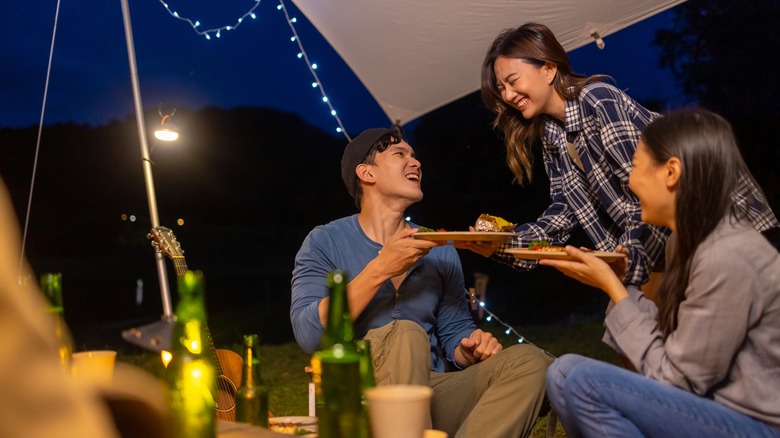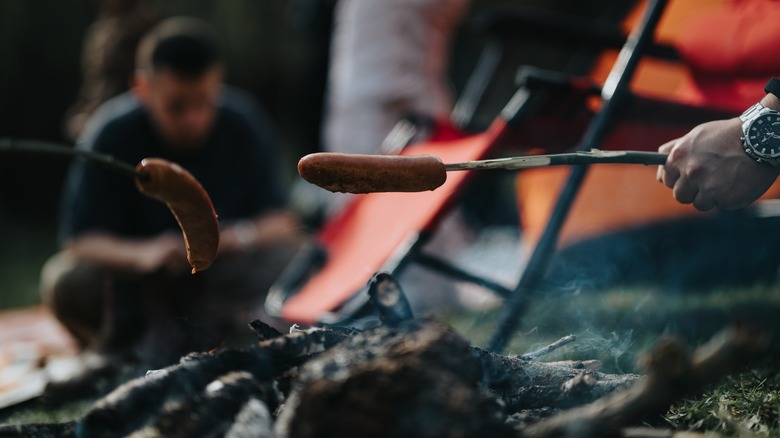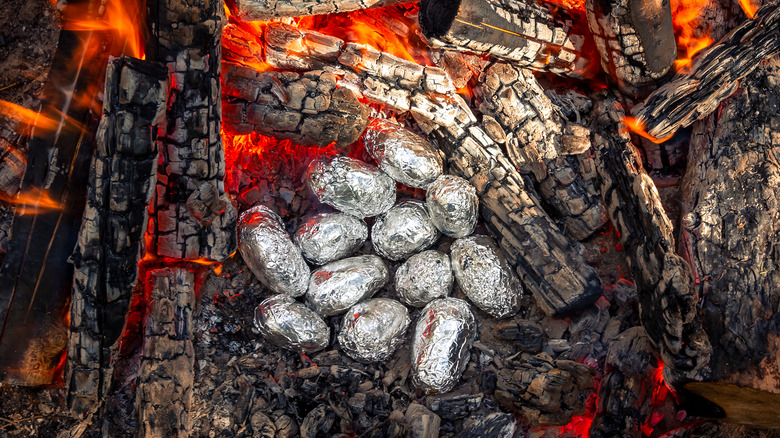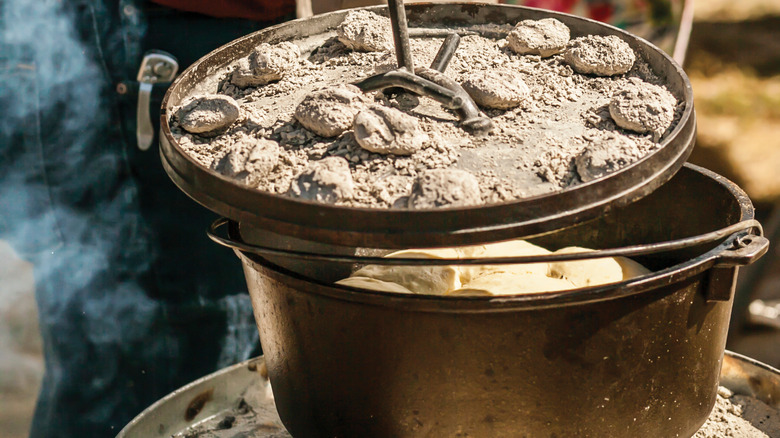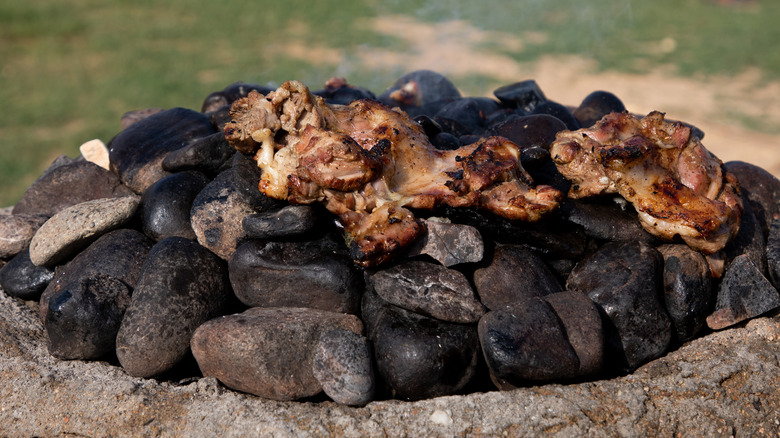Our 5 Favorite Cooking Methods For Tasty Campfire Meals
One of the more enjoyable aspects of camping is cooking over a campfire. Indeed, it seems as if the entire experience isn't complete unless you have had a few tasty campfire meals during your excursion. After all, once you've built that perfect campfire, it's only natural you want to cook a satisfying meal over it.
When it comes to preparing a campfire meal, there are certainly some wrong ways to go about it. However, there is no singular right way to cook over a campfire. In fact, there are a myriad of campfire cooking methods, techniques, and hacks that can yield tasty results. Below are a few of our favorite cooking methods to try next time you're camping. Most of these methods can be used to prepare a meal any time of the day –- breakfast, lunch, or dinner — and be used in conjunction with one another. Also included are some pros and cons for each to help you choose which method –- or methods -– you'd like to try on your next camping trip.
Use skewers and sticks for simple campfire meals
It doesn't get much simpler than jamming some meat, veggies, or marshmallows on a stick and holding it over the fire while it cooks. However, this basic cooking method is perhaps the most iconic campfire cooking technique of all. Virtually everyone who has ever been camping has roasted a hot dog or marshmallow over the campfire using a stick.
Pros of campfire cooking with a stick or skewer: It is incredibly easy. Stick a piece of food on a stick and hold it over the fire until it's done, turning it here and there to ensure even cooking. It is also easy to control the heat by simply moving the food closer or further from the fire. It also requires little to no equipment –- you can either carry pre-made or purchased skewers or simply find an adequate branch when it's time to cook.
Cons of campfire cooking with a stick or skewer: The biggest drawback to this type of cooking is that it is somewhat limiting. There are methods for doing things like making bread on a stick, but for the most part stick cooking is limited to basic meats and veggies. However, you can get a bit creative with the way you combine these elements on the stick. The only other real con to campfire cooking with a stick is you typically have to tend to it the entire time and it is somewhat difficult to cook for large groups.
Foil packets make amazing campfire meals
Aluminum foil has become one of the most useful camping items you can have. There are a variety of ways foil can be used to cook and heat food, whether it be simply wrapping potatoes to place in coals, making full meal flavor packets, or creating makeshift cookware.
Pros to campfire cooking with aluminum foil: One the main pros to cooking with aluminum foil is it is very easy, yet also lends itself to creating more complex meals. You can simply wrap potatoes, fish, meat, or veggies in foil and allow them to remain in the coals, on a rock heated by fire, or over the fire on a campfire grill or makeshift stick grill until they are done. But, you can also create an unimaginable array of full, flavorful foil-packet meals. Aluminum foil is also light and easily transported.
Cons to campfire cooking with aluminum foil: On the downside, using aluminum foil creates trash which is not biodegradable and must be packed out with you. That means carrying it around for the rest of your trip. Additionally, if you are doing anything besides baked potatoes, which can be rolled out of coals with a stick, or a meal which can be easily slid away from the edge of the fire by hand, you need to be prepared with something to remove the foil enwrapped food from fire. This means packing additional utensils or gear for this purpose.
Dutch ovens can be used to make meals and desserts
Dutch ovens are true camp cookware. They are the original all-in-one cooking device and were considered an essential piece of equipment by settlers moving to the American West during the mid-1800s. Yet, these cast-iron cooking implements are every bit as useful to modern-day campers.
Pros to campfire cooking with a Dutch oven: The advantage to campfire cooking with a Dutch oven is versatility. A Dutch oven can be used as a cast-iron cauldron or pot for boiling. It can be used to bake -– hence the "oven" portion of the name. This is accomplished by setting the oven in a bed of coals, then placing coals atop the oven's lipped lid. This causes it to be heated from above and below –- like an oven. When utilized in this manner, campers can bake meals such as casseroles, desserts such as pies, or any number of biscuits and breads. Finally, a Dutch oven can be used as a cast iron skillet, which allows for the cooking of a variety of camp meals. Dutch ovens can also be used to cook meals capable of serving large crowds.
Two big cons to a Dutch oven: They are heavy. This is not an issue if driving to your campsite, but a Dutch oven can be a nightmare to pack if hiking. Also, they do require maintenance to keep them clean and rust-free.
Campfire grills can be used to cook in a variety of ways
Just as backyard pits and grills can be used to cook different foods in a variety of ways, so, too, can campfire grills. The biggest difference is that backyard grills are essentially self-contained, with a basin for the fire/coals, a rack for the grill to set, and a lid. A campfire grill is just the grill itself. It is placed over a fire or bed of coals at the campsite. Some campfire grills have legs, while others need to be balanced atop rocks or logs placed around the campfire or coals.
Pros to campfire cooking with a campfire grill: In a word, versatility. Campfire grills can be used as a cooking surface to prepare items such as steaks, fish, or veggies. They can also be used as a support surface to keep cooking utensils such as coffee pots, frying pans, or pots above the heat source, whether it be flames or coals. In fact, all of the methods mentioned above in this article can actually be used in conjunction with a campfire grill.
Cons to campfire cooking with a campfire grill: Campfire grills can be bulky and cumbersome to pack — at least those with legs and of any substantial size. So, if you are planning to do hike-in camping, be sure to pick a model that is smaller, lighter, and packable. One other con to a campfire grill is some methods of cooking on it require additional implements.
Hot stones provide a natural campfire cooking surface
Cooking with hot rocks or stones is a method that was used by primitive man, but can still be a fun and tasty way to prepare meals for modern-day campers. There are several methods campers can utilize hot rocks or stones for cooking, each of which involves heating the rocks in or above a campfire. Rocks can be dropped into water to heat it, but here we are discussing hot stones as a cooking surface.
To use a stone or rock as a cooking surface, heat it and remove it from the fire with a stick or place it above the fire or coals by balancing it on smaller rocks. It is possible to find a random flat stone that can suit this purpose, but it is perhaps easier to bring a prepared slab, granite, or marble along with you. One last method to creating a cooking surface from rocks is to pile smooth, round stones on top of a bed of coals.
Pros to campfire cooking with hot stones: They provide a natural cooking surface and give a somewhat primitive feel to the camp cooking experience. Some even suggest that food cooked on hot stones has a uniquely delicious flavor.
Cons to campfire cooking with hot stones: The cons to cooking with hot stones are pretty straightforward. Depending on where you camp, finding appropriate stones may be difficult. Conversely, bringing your own cooking stone may be impractical if you are hiking.
